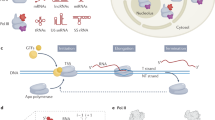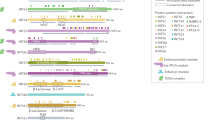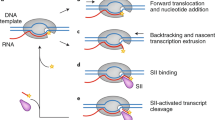Abstract
Several non-coding RNAs (ncRNAs) that regulate eukaryotic mRNA transcription have recently been discovered. Their mechanisms of action and biological roles are extremely diverse, which indicates that, so far, we have only had a glimpse of this new class of regulatory factor. Many surprises are likely to be revealed as further ncRNA transcriptional regulators are identified and characterized.
This is a preview of subscription content, access via your institution
Access options
Subscribe to this journal
Receive 12 print issues and online access
$189.00 per year
only $15.75 per issue
Buy this article
- Purchase on Springer Link
- Instant access to full article PDF
Prices may be subject to local taxes which are calculated during checkout


Similar content being viewed by others
References
Storz, G., Altuvia, S. & Wassarman, K. M. An abundance of RNA regulators. Annu. Rev. Biochem. 74, 199–217 (2005).
Narlikar, G. J., Fan, H. Y. & Kingston, R. E. Cooperation between complexes that regulate chromatin structure and transcription. Cell 108, 475–487 (2002).
Kadonaga, J. T. Regulation of RNA polymerase II transcription by sequence-specific DNA binding factors. Cell 116, 247–257 (2004).
Smale, S. T. & Kadonaga, J. T. The RNA polymerase II core promoter. Annu. Rev. Biochem. 72, 449–479 (2003).
Naar, A. M., Lemon, B. D. & Tjian, R. Transcriptional coactivator complexes. Annu. Rev. Biochem. 70, 475–501 (2001).
Lanz, R. B. et al. A steroid receptor coactivator, SRA, functions as an RNA and is present in an SRC-1 complex. Cell 97, 17–27 (1999).
Lanz, R. B., Razani, B., Goldberg, A. D. & O'Malley, B. W. Distinct RNA motifs are important for coactivation of steroid hormone receptors by steroid receptor RNA activator (SRA). Proc. Natl Acad. Sci. USA 99, 16081–16086 (2002).
Kuwabara, T., Hsieh, J., Nakashima, K., Taira, K. & Gage, F. H. A small modulatory dsRNA specifies the fate of adult neural stem cells. Cell 116, 779–793 (2004).
Shamovsky, I., Ivannikov, M., Kandel, E. S., Gershon, D. & Nudler, E. RNA-mediated response to heat shock in mammalian cells. Nature 440, 556–560 (2006).
Willingham, A. T. et al. A strategy for probing the function of noncoding RNAs finds a repressor of NFAT. Science 309, 1570–1573 (2005).
Orphanides, G., Lagrange, T. & Reinberg, D. The general transcription factors of RNA polymerase II. Genes Dev. 10, 2657–2683 (1996).
Reines, D., Conaway, J. W. & Conaway, R. C. The RNA polymerase II general elongation factors. Trends Biochem. Sci. 21, 351–355 (1996).
Kwek, K. Y. et al. U1 snRNA associates with TFIIH and regulates transcriptional initiation. Nature Struct. Biol. 9, 800–805 (2002).
O'Gorman, W., Thomas, B., Kwek, K. Y., Furger, A. & Akoulitchev, A. Analysis of U1 small nuclear RNA interaction with cyclin H. J. Biol. Chem. 280, 36920–36925 (2005).
Nguyen, V. T., Kiss, T., Michels, A. A. & Bensaude, O. 7SK small nuclear RNA binds to and inhibits the activity of CDK9/cyclin T complexes. Nature 414, 322–325 (2001).
Yang, Z., Zhu, Q., Luo, K. & Zhou, Q. The 7SK small nuclear RNA inhibits the CDK9/cyclin T1 kinase to control transcription. Nature 414, 317–322 (2001).
Yik, J. H. et al. Inhibition of P-TEFb (CDK9/Cyclin T) kinase and RNA polymerase II transcription by the coordinated actions of HEXIM1 and 7SK snRNA. Mol. Cell 12, 971–982 (2003).
Allen, T. A., Von Kaenel, S., Goodrich, J. A. & Kugel, J. F. The SINE-encoded mouse B2 RNA represses mRNA transcription in response to heat shock. Nature Struct. Mol. Biol. 11, 816–821 (2004).
Espinoza, C. A., Allen, T. A., Hieb, A. R., Kugel, J. F. & Goodrich, J. A. B2 RNA binds directly to RNA polymerase II to repress transcript synthesis. Nature Struct. Mol. Biol. 11, 822–829 (2004).
Liu, W. M., Chu, W. M., Choudary, P. V. & Schmid, C. W. Cell stress and translational inhibitors transiently increase the abundance of mammalian SINE transcripts. Nucl. Acids Res. 23, 1758–1765 (1995).
Wassarman, K. M. & Storz, G. 6S RNA regulates E. coli RNA polymerase activity. Cell 101, 613–623 (2000).
Thomas, M. et al. Selective targeting and inhibition of yeast RNA polymerase II by RNA aptamers. J. Biol. Chem. 272, 27980–27986 (1997).
Kettenberger, H. et al. Structure of an RNA polymerase II–RNA inhibitor complex elucidates transcription regulation by noncoding RNAs. Nature Struct. Mol. Biol. 13, 44–48 (2006).
Kugel, J. F. & Goodrich, J. A. Translocation after synthesis of a four-nucleotide RNA commits RNA polymerase II to promoter escape. Mol. Cell. Biol. 22, 762–773 (2002).
Boumil, R. M. & Lee, J. T. Forty years of decoding the silence in X-chromosome inactivation. Hum. Mol. Genet. 10, 2225–2232 (2001).
Almeida, R. & Allshire, R. C. RNA silencing and genome regulation. Trends Cell Biol. 15, 251–258 (2005).
Gollnick, P. & Babitzke, P. Transcription attenuation. Biochim. Biophys. Acta 1577, 240–250 (2002).
Rosen, C. A., Sodroski, J. G. & Haseltine, W. A. The location of cis-acting regulatory sequences in the human T cell lymphotropic virus type III (HTLV-III/LAV) long terminal repeat. Cell 41, 813–823 (1985).
Selby, M. J., Bain, E. S., Luciw, P. A. & Peterlin, B. M. Structure, sequence, and position of the stem–loop in tar determine transcriptional elongation by tat through the HIV-1 long terminal repeat. Genes Dev. 3, 547–558 (1989).
Feng, S. & Holland, E. C. HIV-1 tat trans-activation requires the loop sequence within tar. Nature 334, 165–167 (1988).
Roy, S., Delling, U., Chen, C. H., Rosen, C. A. & Sonenberg, N. A bulge structure in HIV-1 TAR RNA is required for Tat binding and Tat-mediated trans-activation. Genes Dev. 4, 1365–1373 (1990).
Teixeira, A. et al. Autocatalytic RNA cleavage in the human β-globin pre-mRNA promotes transcription termination. Nature 432, 526–530 (2004).
Kaneko, S. & Manley, J. L. The mammalian RNA polymerase II C-terminal domain interacts with RNA to suppress transcription-coupled 3′ end formation. Mol. Cell 20, 91–103 (2005).
Tian, Y. et al. Dissecting protein:protein interactions between transcription factors with an RNA aptamer. RNA 1, 317–326 (1995).
Zhai, G., Iskandar, M., Barilla, K. & Romaniuk, P. J. Characterization of RNA aptamer binding by the Wilms' tumor suppressor protein WT1. Biochemistry 40, 2032–2040 (2001).
Park, M. W., Choi, K. H. & Jeong, S. Inhibition of the DNA binding by the TCF-1 binding RNA aptamer. Biochem. Biophys. Res. Commun. 330, 11–17 (2005).
Ghosh, G., Huang, D. B. & Huxford, T. Molecular mimicry of the NF-κB DNA target site by a selected RNA aptamer. Curr. Opin. Struct. Biol. 14, 21–27 (2004).
Fan, X., Shi, H., Adelman, K. & Lis, J. T. Probing TBP interactions in transcription initiation and reinitiation with RNA aptamers that act in distinct modes. Proc. Natl Acad. Sci. USA 101, 6934–6939 (2004).
Fan, X., Shi, H. & Lis, J. T. Distinct transcriptional responses of RNA polymerases I, II and III to aptamers that bind TBP. Nucl. Acids Res. 33, 838–845 (2005).
Saha, S., Ansari, A. Z., Jarrell, K. A. & Ptashne, M. RNA sequences that work as transcriptional activating regions. Nucl. Acids Res. 31, 1565–1570 (2003).
Acknowledgements
Research in the authors' laboratory is supported by the National Institutes of Health and the National Science Foundation.
Author information
Authors and Affiliations
Ethics declarations
Competing interests
The authors declare no competing financial interests.
Rights and permissions
About this article
Cite this article
Goodrich, J., Kugel, J. Non-coding-RNA regulators of RNA polymerase II transcription. Nat Rev Mol Cell Biol 7, 612–616 (2006). https://doi.org/10.1038/nrm1946
Published:
Issue Date:
DOI: https://doi.org/10.1038/nrm1946
This article is cited by
-
Dysregulated lncRNAs regulate human umbilical cord mesenchymal stem cell differentiation into insulin-producing cells by forming a regulatory network with mRNAs
Stem Cell Research & Therapy (2024)
-
CircFhit Modulates GABAergic Synaptic Transmission via Regulating the Parental Gene Fhit Expression in the Spinal Dorsal Horn in a Rat Model of Neuropathic Pain
Neuroscience Bulletin (2023)
-
The emerging roles and potential applications of circular RNAs in ovarian cancer: a comprehensive review
Journal of Cancer Research and Clinical Oncology (2023)
-
Induction of m6A methylation in adipocyte exosomal LncRNAs mediates myeloma drug resistance
Journal of Experimental & Clinical Cancer Research (2022)
-
LPInsider: a webserver for lncRNA–protein interaction extraction from the literature
BMC Bioinformatics (2022)



